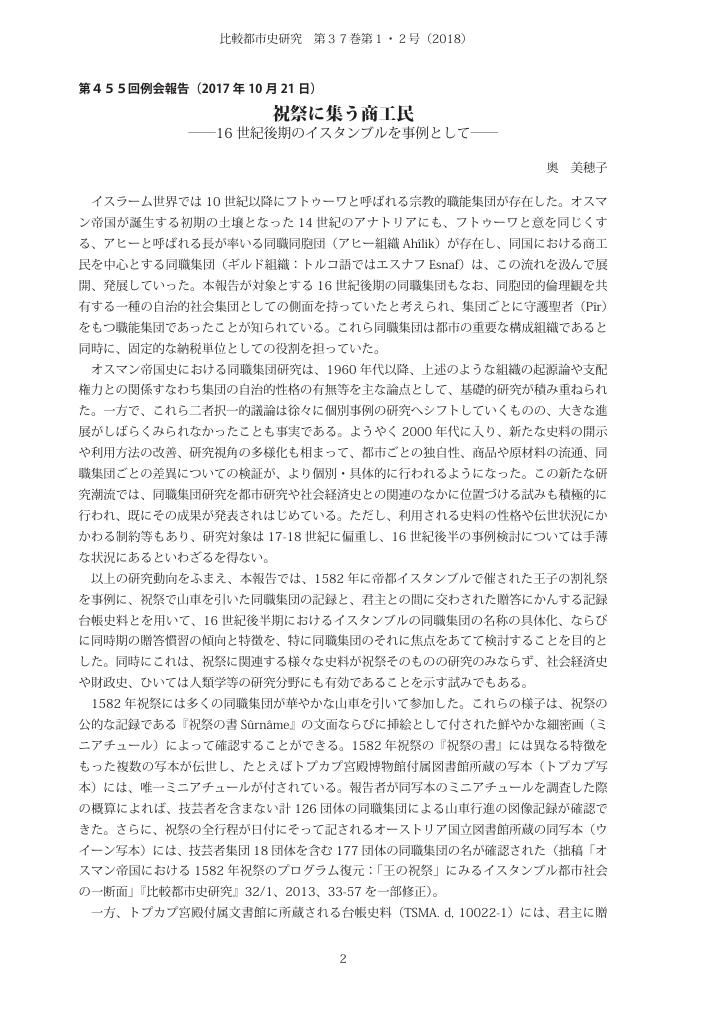- 著者
- 奥 美穂子
- 出版者
- 比較都市史研究会
- 雑誌
- 比較都市史研究 (ISSN:02871637)
- 巻号頁・発行日
- vol.29, no.1, pp.13-30, 2010-06-20
- 著者
- 奥 美穂子
- 出版者
- 日本オリエント学会
- 雑誌
- オリエント = Bulletin of the Society for Near Eastern Studies in Japan (ISSN:00305219)
- 巻号頁・発行日
- vol.60, no.1, pp.64-77, 2017
2 0 0 0 OA オスマン帝国における贈与と返礼 16世紀末の王子の割礼祭を事例として
- 著者
- 奥 美穂子
- 出版者
- 一般社団法人 日本オリエント学会
- 雑誌
- オリエント (ISSN:00305219)
- 巻号頁・発行日
- vol.60, no.1, pp.64-77, 2017-09-30 (Released:2020-10-01)
- 参考文献数
- 37
This paper considers gifting customs between the Ottoman ruler and officers at the Royal Festivity celebrating Prince Mehmeds circumcision in Istanbul in 1582. By analyzing business and accounting records, the customs for gifting and forms of rewards are elucidated.At the circumcision festival in 1582, a wide variety of gifts were presented both domestically and from abroad. Gifts, especially from within the empire, followed the contemporary gifting customs with regard to the types of items and their quantity. A combination of luxury fabrics and vessels was considered to be the basic style, and ritualistically, the number of items was based on the odd numbers so esteemed in the Islamic world. These gifting customs were well rooted and known in the 16th-century Ottoman Empire, especially for the local officers such as beylerbeyis and sancakbeyis.In return, Sultan Murad III gave rewards in various ways. Generally, vassals were rewarded with luxury fabrics and kaftans signifying honours and possessions. These cases also confirmed that cash or tax collection rights, serving vassals as regular income, were given by the Sultan.As for the role of fabrics in the gift exchanges, fabrics were gathered to Istanbul from various areas and some of them were then delivered to the two treasuries of the Empire. In addition, it was fabrics and kaftans made by luxury fabrics that were rewarded to vassals. In other words, fabrics useful as high-quality gifts also functioned as a medium signifying loyalty and protection between the Ottoman ruler and officers in the gift-exchange system of the Ottoman Empire.
2 0 0 0 OA オスマン帝国の「王の祝祭」にみる政治文化 : 1530年と1582年の割礼祭の比較
- 著者
- 奥 美穂子
- 出版者
- 比較都市史研究会
- 雑誌
- 比較都市史研究 (ISSN:02871637)
- 巻号頁・発行日
- vol.29, no.1, pp.13-30, 2010-06-20 (Released:2017-08-25)
1 0 0 0 OA 祝祭に集う商工民 ―16世紀後期のイスタンブルを事例として―
- 著者
- 奥 美穂子
- 出版者
- 比較都市史研究会
- 雑誌
- 比較都市史研究 (ISSN:02871637)
- 巻号頁・発行日
- vol.37, no.1-2, pp.2-3, 2018-12-20 (Released:2019-04-12)
- 著者
- 奥 美穂子
- 出版者
- 明治大学東洋史談話会
- 雑誌
- 明大アジア史論集 = Meiji University journal of Asian history (ISSN:21888140)
- 巻号頁・発行日
- no.23, pp.204-226, 2019-03
- 著者
- 奥 美穂子
- 出版者
- 比較都市史研究会
- 雑誌
- 比較都市史研究 (ISSN:02871637)
- 巻号頁・発行日
- vol.32, no.1, pp.33-57, 2013-06-20 (Released:2017-08-25)


